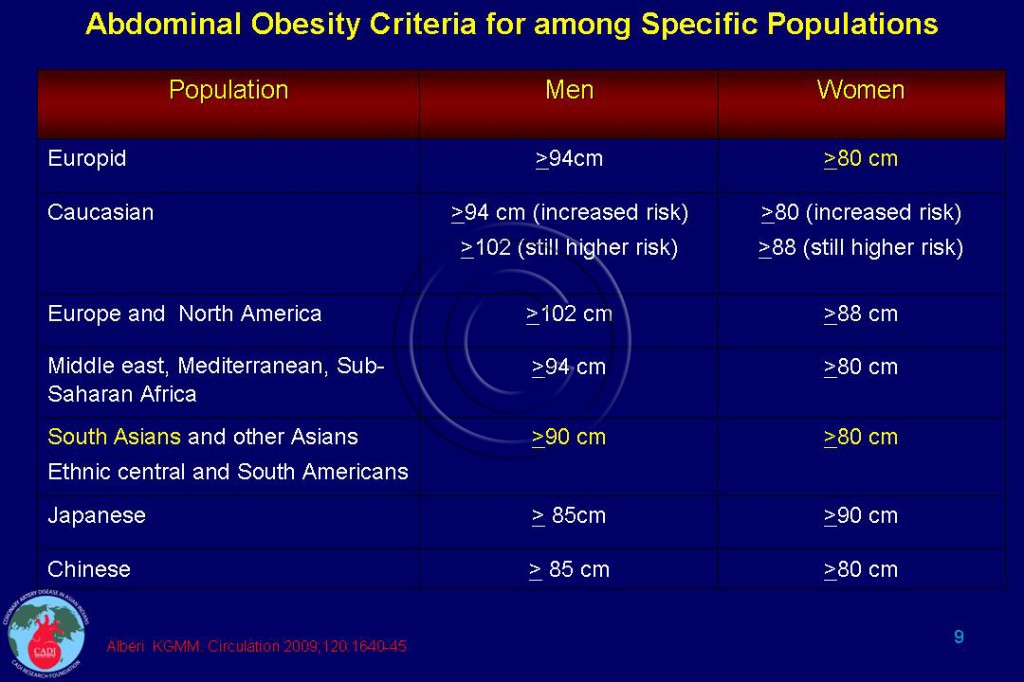Metabolic Syndrome and Abdominal Obesity
- Since the human body is programmed to cope with fasting and feasting, a steady excess consumption of food calories with reduced energy expenditure often leads to visceral fat deposition. Abdominal obesity measured as waist circumference (WC) is a simple and clinically useful measure of visceral fat accumulation, which is the driving force in the development of Metabolic Syndrome (MS).1
- Several studies have showed that Asian Indians have excess cardiovascular risk at body mass Index (BMI) and WC values considered “normal” by western standards leading to lower alternative cut points.2-4
- For comparable BMI and age, healthy Asian Indians have physiologic markers for insulin resistance, dyslipidemia, and increased cardiovascular risk, compared with Europids. Alterations in body fat distribution—particularly increased visceral fat—may contribute to these abnormalities.5
- In the Chinese, the prevalence of MS was 31% by the US National Cholesterol Education Program (NCEP) criteria but increases to 46% using the International Diabetes Federation (IDF) criteria.
- This and other data demonstrate the futility of following the guidelines made for the US population by other populations without making necessary adjustments for baseline characteristics between the populations. Both NCEP and IDF criteria markedly underestimate the prevalence of MS among South Asians by 25-50%.1
- The World Health Organization (WHO) identifies 2 levels of abdominal obesity in Europids depending on risk for metabolic complications. An increased risk occurs at WC of 94 cm in men and 80 cm in women, but risk is substantially higher at 102 cm in men and 88 cm in women.6 Higher thresholds generally are used to define abdominal obesity in the United States, Canada, and Europe. These higher thresholds also are used as the WC cut points to identify the metabolic syndrome in the United States.6
- An expert consultation for WHO indicated that cut points in the Asian population should be 90 cm for men and 80 cm for women. Several different levels have been suggested in Japan, with cutoff points of >85 cm for men and >90 cm for women. In China, cutoff points of >85 cm in men and 80 cm in women have been suggested, and slightly lower values have been suggested in India.6
- If the higher waist circumference cut points is used to diagnose the metabolic syndrome, fewer individuals would be identified as having the syndrome than if the lower cut point is used. This is true for many countries of the world, especially South Asians.
- A Joint Interim Statement of the International Diabetes Federation Task Force on Epidemiology and Prevention; National Heart, Lung, and Blood Institute; American Heart Association; World Heart Federation; International Atherosclerosis Society; and International Association for the Study of Obesity has recommended using ethnic, gender and country specific criteria for abdominal obesity as shown in the A Joint Interim Statement of the International Diabetes Federation Task Force on Epidemiology and Prevention; National Heart, Lung, and Blood Institute; American Heart Association; World Heart Federation; International Atherosclerosis Society; and International Association for the Study of Obesity has recommended using ethnic, gender and country specific criteria for abdominal obesity as shown in the Table 009.6
- The waist circumference 90 cm (35.4 inches) is now considered as unhealthy for Indian men compared 102 or 40 inches for Europids and 80cm or 31.5 inches for Indian women (as opposed to 88cm/34.6 inches).7
- Since the risk begins much earlier, intensive lifestyle changes in Asian Indians should begin when the WC is 78 cm or more in men and 72 cm or more in women. 8
Sources
1. Enas EA, Mohan V, Deepa M, Farooq S, Pazhoor S, Chennikkara H. The metabolic syndrome and dyslipidemia among Asian Indians: a population with high rates of diabetes and premature coronary artery disease. Journal of the cardiometabolic syndrome. Fall 2007;2(4):267-275.
2. Vikram NK, Pandey RM, Misra A, Sharma R, Devi JR, Khanna N. Non-obese (body mass index < 25 kg/m2) Asian Indians with normal waist circumference have high cardiovascular risk. Nutrition (Burbank, Los Angeles County, Calif. Jun 2003;19(6):503-509.
3.Ramachandran A., Snehalatha C, Vijay V. Low risk threshold for acquired diabetogenic factors in Asian Indians. Diabetes Res Clin Pract. Sep 2004;65(3):189-195.
4. Deepa R, Sandeep S, Mohan V. Abdominal obesity, viceral fat, and type 2 diabetes- “Asian Indian Phenotype”. In: Mohan V, Gundu Rao, eds. Type 2 diabetes in South Asians; Epidemiology , Risk factors and Prevention. New Delhi: Jaypee Medical Publishers; 2006:138-152.
5. Raji A, Seely EW, Arky RA, Simonson DC. Body fat distribution and insulin resistance in healthy Asian Indians and Caucasians. The Journal of clinical endocrinology and metabolism. 2001;86(11):5366-5371.
6. Alberti KG, Eckel RH, Grundy SM, et al. Harmonizing the metabolic syndrome: a joint interim statement of the International Diabetes Federation Task Force on Epidemiology and Prevention; National Heart, Lung, and Blood Institute; American Heart Association; World Heart Federation; International Atherosclerosis Society; and international association for the Study of Obesity. Circulation. Oct 20 2009;120(16):1640-1645.
7. Misra A , Chowbey P, Makkar B. Consensus statement for diagnosis of obesity, abdominal obesity, and metabolic syndrome, for Asian Indians and recomendations for physical activity, medical and surgical management. JAPI. 2009;57:163-170.
8. Misra A, Vikram NK, Gupta R, Pandey RM, Wasir JS, Gupta VP. Waist circumference cutoff points and action levels for Asian Indians for identification of abdominal obesity. International journal of obesity (2005). Jan 2006;30(1):106-111.


